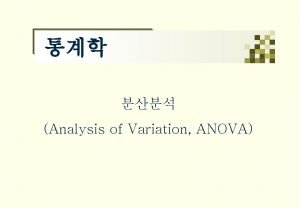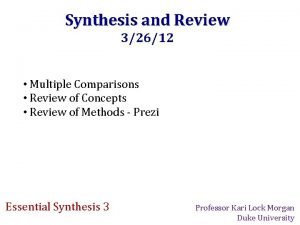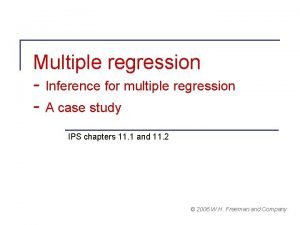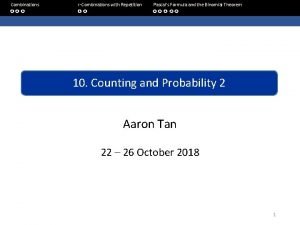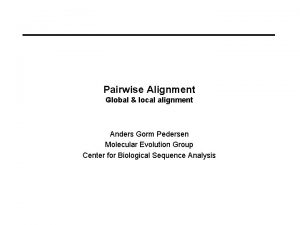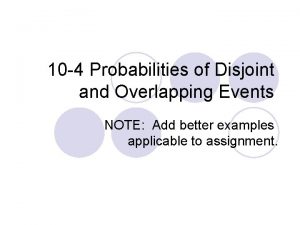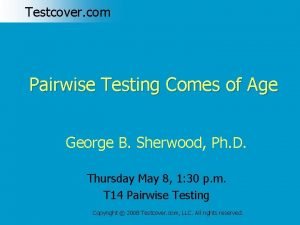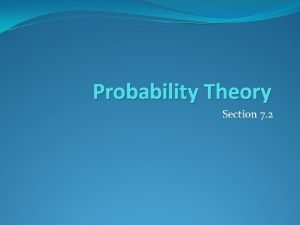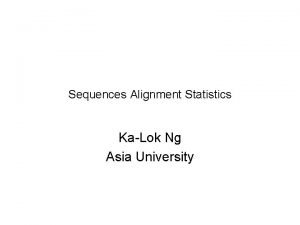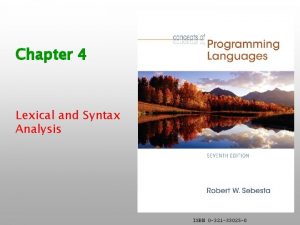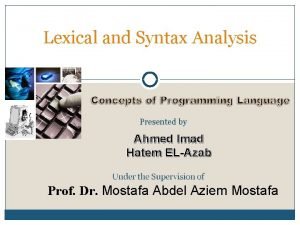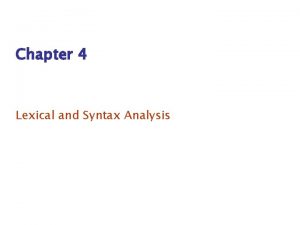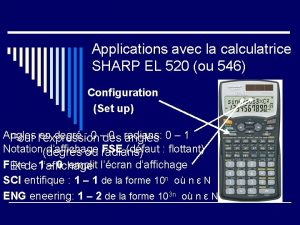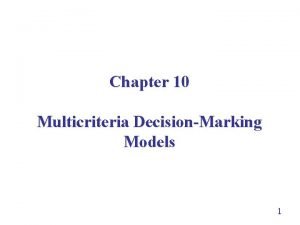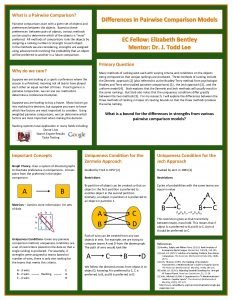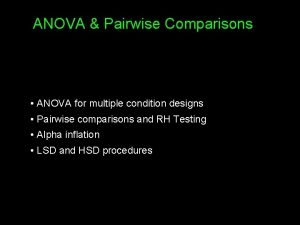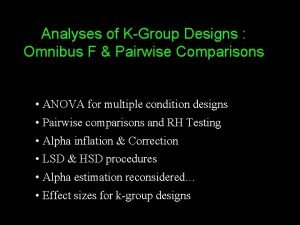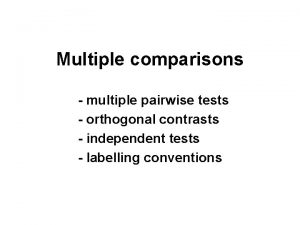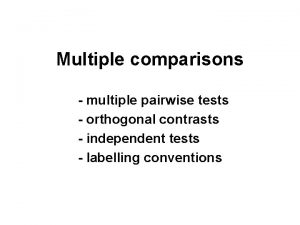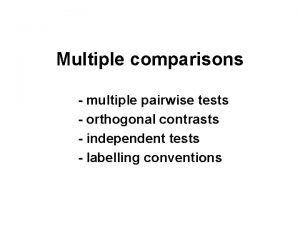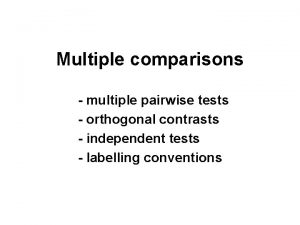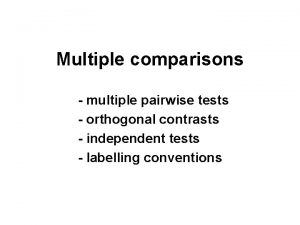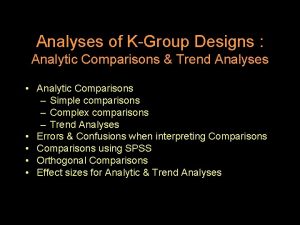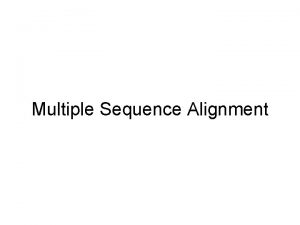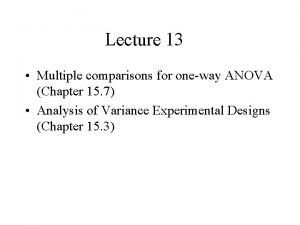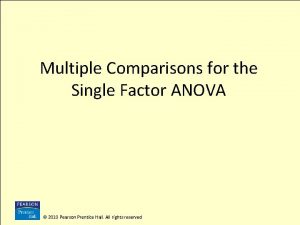kgroup ANOVA Pairwise Comparisons ANOVA for multiple condition

























![Effect Size for 2 -BG designs r = [ F / (F + dferror)] Effect Size for 2 -BG designs r = [ F / (F + dferror)]](https://slidetodoc.com/presentation_image_h/c133e9cae70219abb02b0a75018fa9ec/image-26.jpg)
![Effect Size for 2 -WG designs r = [ F / (F + dferror)] Effect Size for 2 -WG designs r = [ F / (F + dferror)]](https://slidetodoc.com/presentation_image_h/c133e9cae70219abb02b0a75018fa9ec/image-27.jpg)

- Slides: 28

k-group ANOVA & Pairwise Comparisons • ANOVA for multiple condition designs • Pairwise comparisons and RH Testing • Alpha inflation & Correction • LSD & HSD procedures • Alpha estimation reconsidered • Effect size for Pairwise Comparisons

H 0: Tested by k-grp ANOVA n Regardless of the number of IV conditions, the H 0: tested using ANOVA (F-test) is … – “all the IV conditions represent populations that have the same mean on the DV” n When you have only 2 IV conditions, the F-test of this H 0: is sufficient – there are only three possible outcomes … T<C T>C & only one matches the RH n T=C With multiple IV conditions, the H 0: is still that the IV conditions have the same mean DV… T 1 = T 2 = C but there are many possible patterns – Only one pattern matches the Rh:

Omnibus F vs. Pairwise Comparisons n Omnibus F – overall test of whethere any mean DV differences among the multiple IV conditions – Tests H 0: that all the means are equal n Pairwise Comparisons – specific tests of whether or not each pair of IV conditions has a mean difference on the DV n How many Pairwise comparisons ? ? – Formula, with k = # IV conditions # pairwise comparisons = [k * (k-1)] / 2 – or just remember a few of them that are common • 3 groups = 3 pairwise comparisons • 4 groups = 6 pairwise comparisons • 5 groups = 10 pairwise comparisons

Process of statistical analysis for multiple IV conditions designs n Perform the Omnibus-F – test of H 0: that all IV conds have the same mean – if you retain H 0: -- quit n n Compute all pairwise mean differences Compute the minimum pairwise mean diff – formulas are in the Stat Manual -- ain’t no biggie! n Compare each pairwise mean diff with minimum mean diff – if mean diff > min mean diff then that pair of IV conditions have significantly different means – be sure to check if the “significant mean difference” is in the hypothesized direction !!!

Example analysis of a multiple IV conditions design Tx 1 Tx 2 Cx 50 40 35 For this design, F(2, 27)=6. 54, p <. 05 was obtained. We would then compute the pairwise mean differences. Tx 1 vs. Tx 2 10 Tx 1 vs. C 15 Tx 2 vs. C 5 Say for this analysis the minimum mean difference is 7 Determine which pairs have significantly different means Tx 1 vs. Tx 2 Tx 1 vs. C Sig Diff Tx 2 vs. C Not Diff

What to do when you have a RH: The RH: was, “The treatments will be equivalent to each other, and both will lead to higher scores than the control. ” Determine the pairwise comparisons, how the RH applied to each … Tx 1 = Tx 2 Tx 1 > C Tx 1 Tx 2 Cx 85 70 55 Tx 2 > C For this design, F(2, 42)=4. 54, p <. 05 was obtained. Compute the pairwise mean differences. Tx 1 vs. Tx 2 ____ Tx 1 vs. C ____ Tx 2 vs. C ____

Cont. Compute the pairwise mean differences. Tx 1 vs. Tx 2 15 Tx 1 vs. C 30 Tx 2 vs. C 15 For this analysis the minimum mean difference is 18 Determine which pairs have significantly different means Tx 1 vs. Tx 2 No Diff ! Tx 1 vs. C Sig Diff !! Tx 2 vs. C No Diff !! Determine what part(s) of the RH were supported by the pairwise comparisons … RH: Tx 1 = Tx 2 Tx 1 > C Tx 2 > C results Tx 1 = Tx 2 Tx 1 > C Tx 2 = C well ? supported not supported We would conclude that the RH: was partially supported !

Your turn !! The RH: was, “Treatment 1 leads to the best performance, but Treatment 2 doesn’t help at all. ” What predictions does the RH make ? Tx 1 > Tx 2 Tx 1 15 Tx 1 > C Tx 2 9 Cx 11 Tx 2 = C For this design, F(2, 42)=5. 14, p <. 05 was obtained. The minimum mean difference is 3 Compute the pairwise mean differences and determine which are significantly different. 7 Tx 1 vs. Tx 2 ____ 4 Tx 1 vs. C ____ 2 Tx 2 vs. C ____ Your Conclusions ? Complete support for the RH: !!

“The Problem” with making multiple pairwise comparisons -- “Alpha Inflation” n n As you know, whenever we reject H 0: , there is a chance of committing a Type I error (thinking there is a mean difference when there really isn’t one in the population) – The chance of a Type I error = the p-value – If we reject H 0: because p <. 05, then there’s about a 5% chance we have made a Type I error When we make multiple pairwise comparisons, the Type I error rate for each is about 5%, but that error rate “accumulates” across each comparison -- called “alpha inflation” – So, if we have 3 IV conditions and make 3 the pairwise comparisons possible, we have about. . . 3 *. 05 =. 15 or about a 15% chance of making at least one Type I error

Alpha Inflation n Increasing chance of making a Type I error as more pairwise comparisons are conducted Alpha correction n n adjusting the set of tests of pairwise differences to “correct for” alpha inflation so that the overall chance of committing a Type I error is held at 5%, no matter how many pairwise comparisons are made

Here are the pairwise comparisons most commonly used by psychologists (there are several others) Fisher’s LSD (least significance difference) • no alpha correction -- uses =. 05 for each comparison Fisher’s “Protected tests” • no alpha correction -- uses =. 05 for each comparison • “protected” by the omnibus-F -- only perform the pairwise comparisons IF there is an overall significant difference Tukey’s HSD (honestly significant difference) • alpha inflation is controlled by “correcting for” the number of pairwise comparisons available for the number of IV conds

Scheffe’s test • alpha inflation is controlled by “correcting for” the total number of comparisons (simple and complex) available for the number of IV conditions Bonferroni (Dunn’s) correction • alpha inflation is controlled by “correcting for” the actual number of comparisons that are conducted • the p-value for each comparison is set =. 05 / #comparisons Dunnett’s test • used to compare one IV condition to all the others • alpha inflation is controlled for by “correcting for” the number of comparisons and taking into account the interrelation among the comparisons (all use the same “control group”)

Two other techniques that were commonly used over the last two decades but which have “fallen out of favor” (largely because they are more complicated that others that work as well or better) Newman- Keuls and Duncan’s tests • used for all possible pairwise comparisons • called “layered tests” since they apply different criterion for a significant difference to means that are adjacent than those that are separated by a single mean, than by two mean, etc. • Tx 1 -Tx 3 have adjacent means, so do Tx 3 -Tx 2 and Tx 2 -C. Tx 1 -Tx 2 and Tx 3 -C are separated by one mean, and would require a larger difference to be significant. Tx 1 -C would require an even larger difference to be significant. Tx 1 Tx 3 Tx 2 C 10 12 15 16

The “tradeoff” or “continuum” among pairwise comparisons Type II errors Type II errors more “sensitive” more “conservative” Fisher’s Protected Fisher’s LSD Bonferroni HSD Scheffe’s Bonferroni has a “range” on the continuum, depending upon the number of comparisons being “corrected for” Bonferroni is slightly more conservative than HSD when correcting for all possible comparisons

So, now that we know about all these different types of pairwise comparisons, which is the “right one” ? ? ? Consider that each test has a build-in BIAS … • “sensitive tests” (e. g. , Fisher’s Protected Test & LSD) • have smaller mmd values (for a given n & MSerror) • are more likely to reject H 0: (more power - less demanding) • are more likely to make a Type I error (false alarm) • are less likely to make a Type II error (miss a “real” effect) • “conservative tests” (e. g. , Scheffe’ & HSD) • have larger mmd values (for a given n & MSerror) • are less likely reject H 0: (less power - more demanding) • are less likely to make a Type I error (false alarm) • are more likely to make a Type II error (miss a “real effect”)

But, still you ask, which post test is the “right one” ? ? ? Rather than “decide between” the different types of bias, I will ask you to learn to “combine” the results from more conservative and more sensitive designs. If we apply both LSD and HSD to a set of pairwise comparisons, any one of 3 outcomes is possible for each comparison • we might retain H 0: using both LSD & HSD • if this happens, we are “confident” about retaining H 0: , because we did so based not only on the more conservative HSD, but also based on the more sensitive LSD • we might reject H 0: using both LSD & HSD • if this happens we are “confident” about rejecting H 0: because we did so based not only on the more sensitive LSD, but also based on the more conservative HSD • we might reject H 0: using LSD & retain H 0: using HSD • if this happens we are confident about neither conclusion

Here’s an example… A study was run to compare 3 treatments to each other and to a no-treatment control. The resulting means and mean differences were found. M Tx 1 Tx 2 Tx 3 Based on LSD mmd = 3. 9 Based on HSD mmd = 6. 7 Tx 1 12. 3 Tx 2 14. 6 2. 3 Tx 3 18. 8 6. 5 * Cx 22. 9 10. 6 ** 2. 2 8. 3** 4. 1* Conclusions: • confident that Cx > Tx 1 & Cx > Tx 2 -- H 0: lsd & hsd • confident that Tx 2 = Tx 1 & Tx 3 = Tx 2 -- H 0: w/ both lsd & hsd • not confident about Tx 3 - Tx 1 or Cx - Tx 3 -- lsd & hsd differed • next study should concentrate on these comparisons

Computing Pairwise Comparisons by Hand The two most commonly used techniques (LSD and HSD) provide formulas that are used to compute a “minimum mean difference” which is compared with the pairwise differences among the IV conditions to determine which are “significantly different”. t * (2 * MSError) d. LSD = ------------ n t is looked-up from the t-table based on =. 05 and the df = df. Error from the full model q * MSError d. HSD = -------- n q is the “Studentized Range Statistic” -- based on =. 05, df = df. Error from the full model, and the # of IV conditions For a given analysis LSD will have a smaller minimum mean difference than will HSD.

Critical values of t df =. 05 =. 01 1 2 3 4 5 6 7 8 9 10 11 12 13 14 15 16 17 18 19 20 30 40 60 120 12. 71 4. 30 3. 18 2. 78 2. 57 2. 45 2. 36 2. 31 2. 26 2. 23 2. 20 2. 18 2. 16 2. 14 2. 13 2. 12 2. 11 2. 10 2. 09 2. 04 2. 02 2. 00 1. 98 1. 96 63. 66 9. 92 5. 84 4. 60 4. 03 3. 71 3. 50 3. 36 3. 25 3 17 3. 11 3. 06 3. 01 2. 98 2. 95 2. 92 2. 90 2. 88 2. 86 2. 84 2. 75 2. 70 2. 66 2. 62 2. 58 Values of Q error df For k=4 & df=30… LSD is based on t=2. 04, while HSD is based on Q=3. 85 HSD > LSD for any design & df ! 5 6 7 8 9 10 11 12 13 14 15 16 17 18 19 20 30 40 60 120 # IV conditions 3 4 5 6 4. 60 5. 22 4. 34 4. 90 4. 16 4. 68 4. 04 4. 53 3. 95 4. 41 3. 88 4. 33 3. 82 4. 26 3. 77 4. 20 3. 73 4. 15 3. 70 4. 11 3. 67 4. 08 3. 65 4. 05 3. 63 4. 02 3. 61 4. 00 3. 59 3. 98 3. 58 3. 96 3. 49 3. 85 3. 44 3. 79 3. 40 3. 74 3. 36 3. 68 3. 31 3. 63 5. 67 5. 30 5. 06 4. 89 4. 76 4. 65 4. 57 4. 51 4. 45 4. 41 4. 37 4. 33 4. 30 4. 28 4. 25 4. 23 4. 10 4. 04 3. 98 3. 92 3. 86 6. 03 5. 63 5. 36 5. 17 5. 02 4. 91 4. 82 4. 75 4. 69 4. 64 4. 59 4. 56 4. 52 4. 49 4. 47 4. 45 4. 30 4. 23 4. 16 4. 10 4. 03

Using the Pairwise Computator to find the mmd for BG designs K=# conditions N/k=n Use these values to make pairwise comparisons

Using the Pairwise Computator to find mmd for WG designs K=# conditions N=n Use these values to make pairwise comparisons

Some common questions about applying the lsd/hsd formulas… What is “n” for a within-groups design ? Since “n” represents the number of data points that form each IV condition mean (in index of sample size/power), n = N (since each participant provides data in each IV condition) What is “n ” if there is “unequal-n” ? Use the “average n” from the different conditions. This is only likely with BG designs -- very rarely is there unequal n in WG designs, and most computations won’t handle those data.

Applying Bonferroni Unlike LSD and HSD, Bonferroni is based on computing a “regular” t/F-test, but making the “significance” decision based on a p-value that is adjusted to take into account the number of comparisons being conducted. Imagine a 4 -condition study - three Tx conditions and a Cx. The RH: is that each of the TX conditions will lead to a higher DV than the Cx. Even though there are six possible pairwise comparisons, only three are required to test the researcher’s hypothesis. To maintain an experiment-wise Type I error rate of. 05, each comparison will be evaluated using a comparison-wise p-value computed as With p=. 05 for 3 comparisons our experiment-wise Type I error rate would be … E = # comparisons * C = 3 *. 05 = 15% If we wanted to hold out experiment-wise Type I rate to 5%, we would perform each comparison using… E / # comparisons = C . 05 / 3 =. 0167

A few moments of reflection upon “Experiment-wise error rates” the most commonly used E estimation formula is … E = C * # comparisons e. g. , . 05 * 6 =. 30, or a 30% chance of making at least 1 Type I error among the 6 pairwise comparisons But, what if the results were as follows (LSDmmd = 7. 0) Tx 1 Tx 2 Tx 3 C 12. 6 14. 4 16. 4 22. 2 Tx 1 Tx 2 Tx 3 C We only rejected H 0: for 2 of the 6 pairwise comparisons. We 1. 8 can’t have made a Type I error 3. 8 2. 0 for the other 4 -- we retained the 9. 6* 7. 8* 5. 8 H 0: !!! At most our E is 10% -- 5% for each of 2 rejected H 0: s

Here’s another look at the same issue… imagine we do the same 6 comparisons using t-tests, so we get exact p-values for each analysis… Tx 2 -Tx 1 p. =. 43 C-Tx 1 p. =. 005* Tx 3 -Tx 1 p. =. 26 C-Tx 2 p. =. 01 * Tx 3 -Tx 2 p. =. 39 C-Tx 3 p. =. 14 We would reject H 0: for two of the pairwise comparisons. . . What is our E for this set of comparions? Is it …. 05 * 6 =. 30, because we willing to take a 5% chance on each of the 6 pairwise comparisons ? . 05 * 2 =. 10, because we would have rejected H 0: for any p <. 05 for these two “significant” comparisons ? . 005 +. 01 =. 015, because that is the accumulated chance of making a Type I error for the two comparisons that were significant?
![Effect Size for 2 BG designs r F F dferror Effect Size for 2 -BG designs r = [ F / (F + dferror)]](https://slidetodoc.com/presentation_image_h/c133e9cae70219abb02b0a75018fa9ec/image-26.jpg)
Effect Size for 2 -BG designs r = [ F / (F + dferror)] Effect Size & Power Analyses for k-BG designs you won’t have F-values for the pairwise comparisons, so we will use a 2 -step computation d = (M 1 - M 2 ) / MSerror d² r = ----- d² + 4 (This is an “approximation formula”)
![Effect Size for 2 WG designs r F F dferror Effect Size for 2 -WG designs r = [ F / (F + dferror)]](https://slidetodoc.com/presentation_image_h/c133e9cae70219abb02b0a75018fa9ec/image-27.jpg)
Effect Size for 2 -WG designs r = [ F / (F + dferror)] Effect Size for k-WG designs you won’t have F-values for the pairwise comparisons, so we will use a 3 -step computation d = (M 1 - M 2 ) / (MSerror * 2) dw = d * 2 d² r = ----- d² + 4 (This is an “approximation formula”)

Combing these different types of information … Cx mean M dif r 4. 3 . 22 Tx 1 M dif r Cx 20. 3 Tx 1 24. 6 Tx 2 32. 1 11. 8* * . 54 7. 5* . 41 * indicates mean difference is significant based on LSD criterion (min dif = 6. 1) * Indicates the mean difference is significant based on HSD criterion (min dif = 8. 4) Examining these results… • Comparisons with Tx 2 both medium-large to large effect sizes, but only Cx is significantly different when HSD is applied (more conservative & less power than LSD) • The effect size of Cx vs. Tx 1 is substantial (Cohen calls. 30 “medium and. 10 small”), but is not significant by either LSD or HSD, suggesting we should check the power/sample size of the study for testing an effect of this size.
 Pairwise comparison anova
Pairwise comparison anova Xkcd 882
Xkcd 882 Gd&t symbols
Gd&t symbols One way anova vs two way anova
One way anova vs two way anova Pertanyaan tentang anova
Pertanyaan tentang anova Beda one way anova dan two way anova
Beda one way anova dan two way anova Anova multiple regression
Anova multiple regression Pairwise independent
Pairwise independent Global vs local alignment
Global vs local alignment Overlapping vs disjoint
Overlapping vs disjoint Pairwise.org
Pairwise.org Pairwise independent
Pairwise independent Ebi pairwise alignment
Ebi pairwise alignment Types of corelation
Types of corelation Listwise vs pairwise
Listwise vs pairwise Pairwise key
Pairwise key Pict tool
Pict tool Greedy algorithm
Greedy algorithm Pairwise alignment
Pairwise alignment Pairwise disjoint test
Pairwise disjoint test Pairwise disjointness test
Pairwise disjointness test Lexical and syntax analysis
Lexical and syntax analysis Pairwise comparison chart
Pairwise comparison chart Pairwise alignment
Pairwise alignment Sharp el-546x
Sharp el-546x Pairwise comparison matrix
Pairwise comparison matrix Tukey pairwise comparison minitab
Tukey pairwise comparison minitab Pairwise comparison
Pairwise comparison Blast pairwise alignment
Blast pairwise alignment
